Contents (Jump to a section)
How to Fix a Tight Hamstring: What to do to Relieve Hamstring Tightness Quickly
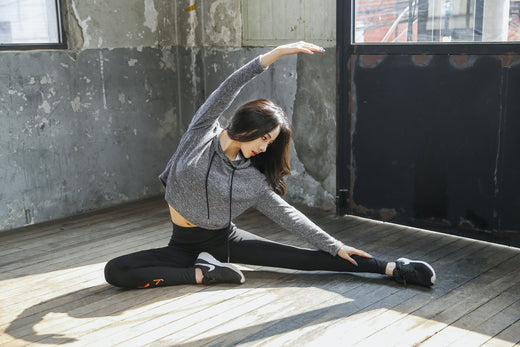
-
Main Causes of Tight Hamstrings
- 1.1 Sitting Too Long
- 1.2 Sedentary Lifestyle
- 1.3 Exercise
- 1.4 Possible Injury
- 1.5 Weak Hamstrings
- 1.6 Poor Hip Mobility, Flexibility, & Stability
- Tight Hamstrings Symptoms
- How Long Does it Take to Fix a Tight Hamstring?
-
How to Releave Tight Hamstrings
- 4.1 Stretching
- 4.2 Deep Tissue Work
- 4.3 Exercise
- 4.4 Foam Roller
- 4.5 Physical Therapy
- 4.6 Heat Therapy
- 4.7 Cold Therapy
- Best Stretches for Tight Hamstrings
- Benefits Of Hamstrings Stretching
- Why Won’t My Hamstrings Loosen Up Even After This Advice?
- Final Thoughts on What to do For a Tight Hamstring
Dealing with a tight hamstring or hamstrings can be insufferable. The tightness can restrict movement, making simple tasks such as walking or sitting challenging. Figuring out what to do for a tight hamstring can procreate numerous results. That’s why we’re here to show you how to relieve hamstring tightness as effectively as possible with the best suitable methods.
The hamstrings are an important muscle in the body, responsible for supporting and enacting movements in the knees and hips. When the hamstrings are weak, tight, or injured, it can cause problems and restrictions in movements such as squatting, flexing the knees, and walking.
Addressing tight hamstrings is crucial to preventing any limitations in everyday movements and decreasing any risks of injury that can affect the quality of life. Follow along below for information on how to quickly fix a tight hamstring!
Main Causes of Tight Hamstrings
Before we discuss how to relieve hamstring tightness, it’s crucial to pinpoint what is causing the hamstrings to become so tight. Doing so can help determine what to do for a tight hamstring and how to prevent a tight hamstring in the future.
Sitting Too Long
Whether sitting too long because you have the day or weekend off, attending classes for school, or working at a desk, these factors can contribute to tight hamstrings. While sitting, the muscles in the hip flexors in the front contract and tighten. This action notifies the nerves to inhibit or turn off the glutes, the muscle on the other side of the joint, resulting in a natural phenomenon called altered reciprocal inhibition.
If the glutes are weak, this causes the hamstrings to take over in place of the glutes, which results in tight hamstrings.
Sedentary Lifestyle
For individuals with a sedentary lifestyle, which involves sitting often and a low activity level, you likely have tight hamstrings.
This study showed that sitting for prolonged periods can cause tight hamstrings and affect the lumbar spine's curvature. Another study assessed a sedentary lifestyle and prolonged sitting of 6-8 hours and continued to validate the assessment that long-duration sitting caused tight hamstrings.
Exercise
If the hamstrings are overworked or targeted during a workout, they can become tight. Intense exercise or trying out a new exercise routine can also strain the hamstrings, leading to tightness. Some examples of activities that cause tight hamstrings include sports and hamstrings curls.
Possible Injury
If the hamstrings are weak, tight, or placed too much strain, it can result in injury. And sometimes, tightness in the hamstrings is caused by an injury that makes the hamstrings more inclined to become tight, like a sprain or strain.
Weak Hamstrings
When the hamstrings are weak, if placed under strain that the muscles are not accustomed to or cannot adapt to, it can result in tightness, injury, or other issues like knee pain. Strengthening and stretching the hamstrings can prevent tightness while providing more support in the hamstring's designated functions to support the back and pelvis.
Poor Hip Mobility, Flexibility, & Stability
If hip mobility and stability are lacking, it can overload the hamstrings that have to work to compensate for the lack of support and strain placed upon it. In this situation, the strength of the hamstring does not need to be addressed. However, hip mobility and stability do through targeted stretching.
When it comes to how long it takes to increase flexibility, it can differ from person to person. However, learning the importance of these qualities can benefit you in the long run for addressing various problems, such as ever needing to know how to release tight calves in the future.
Tight Hamstrings Symptoms
Learning how to relieve hamstring tightness is crucial. If you don’t take the time to find out how to fix a tight hamstring, it can raise the potential of suffering from an injury.
Focusing on strength, mobility, and flexibility of the hamstring muscles can do wonders in preventing concerns like:
- Sprains
- Hamstring Soreness
- Strains
- Lower back pain
- Joint pain
- Chronic pain
- Inflammation
- Swelling
- Difficulty walking
None of these symptoms of injuries caused by tight hamstrings are a pleasure to experience. However, if not addressed, tight hamstrings can lead to chronic pain, affecting the overall quality of life.
How Long Does it Take to Fix a Tight Hamstring?
Consistency and persistence must be emplaced to see progress in fixing a tight hamstring.
Starting out stretching a tight hamstring, you may notice temporary relief from joint pain and stiffness of a tight hamstring. But achieving more long-lasting results will require anywhere from a few weeks to a few months to successfully relieve any tightness in the hamstring.
If lifestyle choices, poor exercise form, lack of flexibility or mobility, or weakness in the hamstrings are not addressed, it will not prevent the likelihood of tight hamstrings from returning. However, adding preventable maneuvers into your routine will work wonders in preventing and addressing tight hamstrings.
How to Releave Tight Hamstrings
Handling what to do for a tight hamstring involves incorporating effective methods for releasing muscle tension. Below, we discuss various ways, like stretching and exercise, to address tight hamstrings for quick relief!
Stretching
Targeting tight hamstrings through stretching can improve mobility in the hip and flexibility of the hamstring. And the benefits of assisted stretching go even further by achieving deeper stretches to alleviate tight muscles by improving circulation and blood flow to the area for reduced inflammation and tension.
Assisted stretches utilize the assistance of another person, or sometimes a helpful tool, to achieve a broader and deeper range of movement during stretching that could otherwise not be achieved on one’s own. Through the help of assisted stretching, mobility is enhanced, flexibility is gained, stress is decreased on the muscles and joints, and muscle tightness is targeted to release tension in the muscle.
And for more improvements on how to quickly relieve tight hamstrings, discover what is fascial stretch therapy, a gentle yet stimulating assisted stretching technique that can be performed in the comfort of your home or anywhere with a flat surface.
Deep Tissue Work
The use of deep tissue work can be an excellent way to relieve tightness in the hamstrings quickly. The fascia and muscles are targeted to increase blood flow and circulation through deep tissue work. This alleviates pain and releases tension while reducing inflammation and pain caused by tightness in the fascia and muscles.
Exercise
If your tight hamstrings are caused by weakness, add hamstring strengthening exercises to prevent weakness and improve strength in the muscle. Some examples of hamstring-focused exercises include Romanian deadlifts, hamstring curls, good mornings, kettlebell swings, and hip thrusts.
Weakness in surrounding muscles, the glutes, and hip flexors can also instigate tightness in the hamstrings. By strengthening these muscles, the strain placed on the hamstrings will be reduced, preventing or relieving the hamstrings of tightness.
Foam Roller
Using a foam roller on tight hamstrings can increase blood flow and circulation to the surrounding area, encouraging the tension to release from the muscle.
Foam rollers target fascia, the thin connective tissue surrounding and supporting the muscles. When fascia becomes tight, it can reduce flexibility, raise the risk of injury, and cause pain. This systematic review assessed foam rolling and concluded that this method increases the range of motion, eases muscle stiffness, and decreases pain.
Physical Therapy
Physical therapy is recommended if you are suffering from an injury or are in desperate need of professional help.
With the help of a physical therapist, you will be prescribed various exercises, stretches, and homework to complete to improve the strength and flexibility of your hamstrings or associated weakness in other muscle groups that may be causing tightness in the hamstrings. This route can be more expensive than other methods but may be necessary if experiencing a severe injury.
Heat Therapy
Heat therapy, also known as thermotherapy, can be used before or after a workout to relax tight hamstrings. In addition, heat therapy can come in handy when noting any stiffness or aching in the joints or muscles by reducing tension and improving circulation.
Some gyms have a sauna that can be used before or after a workout to prevent soreness, warm up the muscles, and avoid stiffness.
Cold Therapy
Cold therapy, or cryotherapy, relieves stiffness and chronic pain by restricting blood flow to the targeted area. This acts to reduce swelling and inflammation for pain reduction. Heat therapy is a better option for relieving tightness in the hamstring, while cold therapy is an excellent option for helping reduce pain and swelling associated with a tight hamstring.
Best Stretches for Tight Hamstrings
Try these stretches to reach more flexibility and strength for your hamstrings.Don’t forget to warm up before training and remember about hydration intake during the exercises.
Toe Touch Stretch
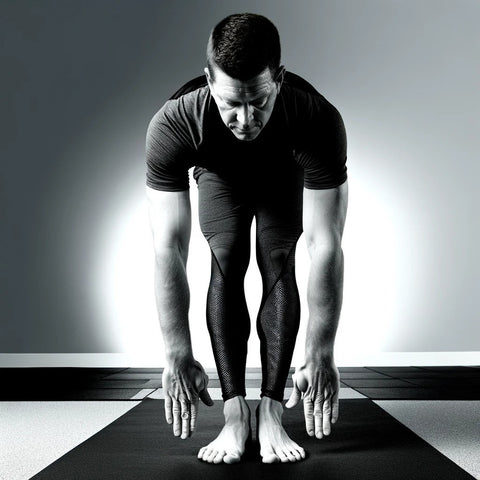
The toe touch stretch is a fundamental exercise to enhance flexibility in the lower back, hamstrings, and calves. To perform this stretch, stand with your feet hip-width apart and slowly bend forward from your waist, reaching down toward your toes. Keep your knees slightly bent to avoid strain. This stretch not only improves flexibility but also promotes better posture and can alleviate tension in the lower back.
Seated Forward Bend
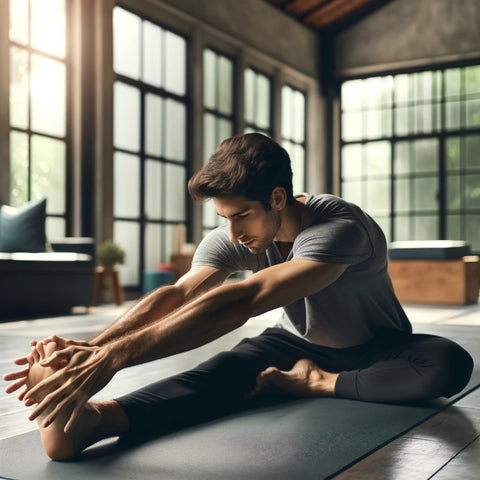
The seated forward bend is an effective stretch for targeting the hamstrings and lower back. Sit on the floor with your legs extended in front of you. Hinge at your hips and reach forward toward your toes. This stretch provides a deep elongation of the hamstrings and helps release tension in the spine. Regular practice can contribute to improved flexibility and reduced stiffness in the lower back and legs.
Standing Hamstring Stretch
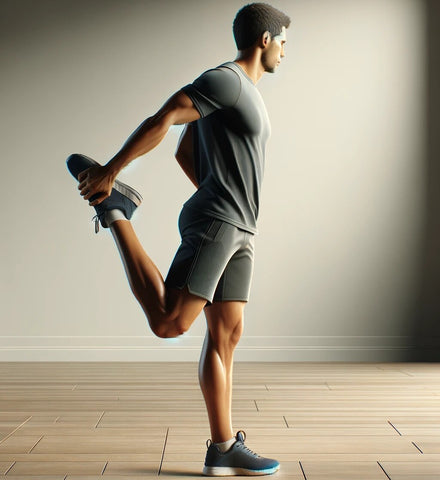
The standing hamstring stretch is a convenient and versatile exercise that can be done anywhere. While standing, extend one leg in front of you with the heel on the ground and toes pointing upward. Hinge at your hips, reaching toward the toes of your extended leg. This stretch targets the hamstrings and also engages the calf muscles. It's a quick way to relieve tightness in the back of the legs.
Lying Hamstring Stretch
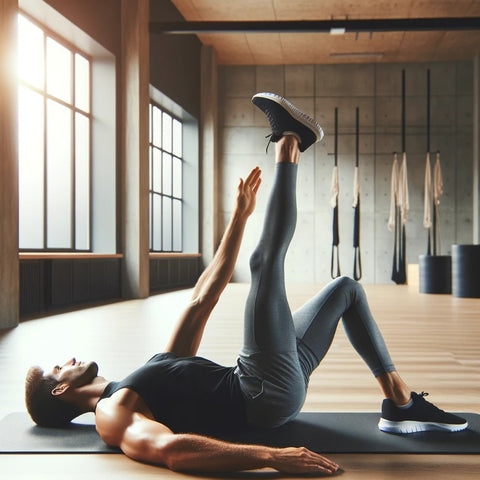
The lying hamstring stretch is performed on your back, offering a comfortable and controlled position. Lie on your back with one leg extended upward, keeping the knee slightly bent. Hold the back of your thigh and gently pull your leg toward your chest. This stretch isolates the hamstrings and provides a gentle stretch to the lower back. Switch legs to ensure both sides receive equal attention.
Benefits Of Hamstrings Stretching
Incorporating hamstring stretches into your daily routine offers significant benefits for relieving tightness and enhancing overall flexibility. Here are key advantages:
- Lengthens Hamstring Muscles: Stretching directly targets the hamstrings, located at the back of the thigh, helping to reduce the risk of strains and injuries during physical activities.
- Improves Range of Motion: Regular hamstring stretches can significantly enhance your flexibility, making daily tasks and movements easier and more efficient.
- Alleviates Lower Back Discomfort: By relieving pressure on the lumbar spine, these stretches can reduce lower back pain, a common issue associated with tight hamstrings.
- Promotes Blood Circulation: Stretching the hamstrings boosts blood flow to the muscle tissue, aiding in quicker recovery post-exercise and diminishing muscle soreness.
- Supports an Active Lifestyle: Regularly practicing hamstring stretches contributes to maintaining muscle health, enabling a more vigorous and pain-free way of living.
By focusing on the benefits of hamstring stretching, individuals can take an important step towards improving their physical well-being and mobility.
Why Won’t My Hamstrings Loosen Up Even After This Advice?
If you want to learn how to quickly fix a tight hamstring, then CastleFlexx’s flexibility equipment is the best option for optimality and effectiveness!
Our flexibility equipment gives you the power of assisted stretching without needing another person, so you can achieve deeper stretches whenever you want. Easy to transport with easy access to full-body stretching, this assisted stretching tool will relieve tight hamstrings while helping improve flexibility, strength, and mobility.
Final Thoughts on What to do For a Tight Hamstring
There are many methods of addressing what to do for a tight hamstring, like weakness, mobility, or lifestyle factors promoting tightness in the muscle.
And throughout this article, we showed how to fix a tight hamstring with various methods like stretching, heat therapy, physical therapy, and exercise. Out of all these methods, stretching with CastleFlexx’s flexibility equipment is the most beneficial in helping you relieve tightness in the hamstrings with deep stretching.
Relieve tight hamstrings today with CastleFlexx’s flexibility equipment!
